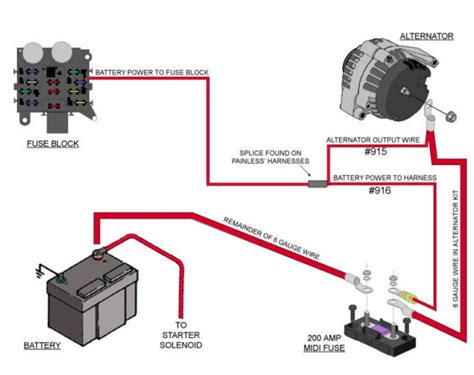1-Wire Alternator Wiring: Guaranteed Success!
The allure of a simplified electrical system is strong, especially for those working on classic cars, motorcycles, or custom projects. A 1-wire alternator setup offers just that – a streamlined approach that eliminates the complexity of multiple wires and voltage regulators. But while seemingly straightforward, improper wiring can lead to charging problems and even damage to your electrical system. This guide will provide a comprehensive understanding of 1-wire alternator wiring, ensuring your project's success.
This article is written by a seasoned automotive enthusiast with over 15 years of experience in custom vehicle builds and electrical system upgrades. While I can't guarantee every outcome, following these instructions meticulously will dramatically increase your chances of a successful 1-wire alternator installation.
What is a 1-Wire Alternator?
Unlike traditional alternators with multiple wires for excitation, voltage regulation, and battery sensing, a 1-wire alternator utilizes a single wire to connect to the battery. This simplification is achieved by integrating the voltage regulator directly into the alternator's design. The alternator's output is self-regulating; it senses the battery's voltage and adjusts its output accordingly.
Advantages of a 1-Wire Alternator System
- Simplicity: The biggest advantage is its ease of installation and reduced wiring complexity. Fewer connections mean less chance of errors and troubleshooting.
- Cost-Effectiveness: Generally, 1-wire alternators are more affordable than their multi-wire counterparts, especially if you consider the reduced wiring costs.
- Cleanliness: A cleaner engine bay is a welcome side effect, enhancing the overall aesthetics of your project.
Disadvantages of a 1-Wire Alternator System
- Potential for Overcharging: Without a properly functioning internal regulator, the alternator may overcharge the battery, leading to damage. Selecting a high-quality alternator is crucial.
- Limited Adjustability: You have less control over the charging characteristics compared to systems with external regulators.
- Compatibility: Not all alternators are designed for 1-wire operation. It's vital to choose an alternator specifically rated for this configuration.
How to Wire a 1-Wire Alternator: A Step-by-Step Guide
Tools and Materials:
- 1-Wire Alternator (ensure it's compatible with your vehicle's voltage and amperage requirements)
- Appropriate gauge wire (usually 8-10 gauge for high-output alternators)
- Ring terminals
- Inline fuse (at least 100 amps, ideally closer to the alternator's maximum output)
- Electrical tape
- Crimping tool
- Multimeter
- Wrench set
Steps:
-
Disconnect the Battery: This is crucial for safety. Always disconnect the negative terminal before starting any electrical work.
-
Install the Alternator: Mount the 1-wire alternator in its designated location, ensuring proper alignment and belt tension.
-
Connect the Positive Wire: Attach one end of your appropriately sized wire to the positive (+) terminal of the alternator using a ring terminal. Secure the connection with a crimp and electrical tape.
-
Install the Inline Fuse: Install the inline fuse close to the alternator's positive terminal. This protects your electrical system in case of a short circuit.
-
Connect to Battery Positive Terminal: Connect the other end of the wire (passing through the inline fuse) to the positive (+) terminal of your battery, again using a ring terminal and securing it thoroughly.
-
Grounding: Ensure the alternator case is properly grounded to the engine block using a suitable grounding strap or wire. A clean, secure ground is vital for proper operation.
-
Reconnect the Battery: Carefully reconnect the battery's negative terminal.
-
Test the System: Start your engine and use a multimeter to check the battery voltage. The voltage should be around 13.5-14.5 volts while the engine is running. A lower voltage indicates a problem, while a significantly higher voltage suggests overcharging.
-
Adjust as Necessary: Some 1-wire alternators have a small adjustment screw on the back that allows fine-tuning of voltage output. This is usually only needed if you encounter overcharging problems. Consult the alternator's documentation for details.
Troubleshooting Common Problems
Problem: Alternator not charging.
Possible Causes:
- Loose connections: Double-check all connections for tightness and proper crimping.
- Blown fuse: Replace the inline fuse if it has blown.
- Faulty alternator: The alternator itself may be defective.
- Poor ground: Ensure a good ground connection between the alternator case and engine block.
Problem: Overcharging.
Possible Causes:
- Internal regulator malfunction: If the internal regulator is failing, you may need to replace the alternator.
- Incorrect alternator selection: An incorrectly sized alternator can overcharge.
- Adjustment needed: If there's an adjustment screw, fine-tune the voltage output as directed by the alternator's specifications.
Is a 1-Wire Alternator Right for You?
The decision to use a 1-wire alternator hinges on your specific project requirements. For simplified setups where a clean engine bay and ease of installation are prioritized, it's a great choice. However, if precise voltage control or high-amperage requirements are crucial, a more complex system might be necessary.
Frequently Asked Questions (FAQs)
<h3>Can I use a 1-wire alternator in any vehicle?</h3> No. 1-wire alternators require specific characteristics in their internal regulator and are not universally compatible. Ensure your chosen alternator is specifically designed for 1-wire operation and matches the voltage and amperage requirements of your system.
<h3>How do I determine the correct amperage rating for my 1-wire alternator?</h3> The amperage rating should be chosen based on your vehicle's electrical demands. Consider the total power draw of all your electrical components (lights, stereo, etc.) and select an alternator with a higher amperage rating to ensure sufficient charging capacity.
<h3>What happens if the 1-wire alternator overcharges?</h3> Overcharging can severely damage your battery, potentially leading to premature failure and even causing damage to other electrical components in your vehicle.
This guide provides a comprehensive understanding of 1-wire alternator wiring. By carefully following these instructions and taking necessary precautions, you can significantly increase your chances of a successful installation, enjoying the benefits of a cleaner and more simplified electrical system. Remember, safety is paramount – if unsure about any step, consult a qualified automotive electrician.

